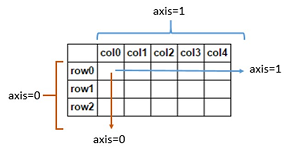11 KiB
NumPy Operations¶
Arithmetic¶
You can easily perform array with array arithmetic, or scalar with array arithmetic. Let's see some examples:
import numpy as np
arr = np.arange(0,10)
arr
arr + arr
arr * arr
arr - arr
# This will raise a Warning on division by zero, but not an error!
# It just fills the spot with nan
arr/arr
# Also a warning (but not an error) relating to infinity
1/arr
arr**3
Universal Array Functions¶
NumPy comes with many universal array functions, or ufuncs, which are essentially just mathematical operations that can be applied across the array.
Let's show some common ones:
# Taking Square Roots
np.sqrt(arr)
# Calculating exponential (e^)
np.exp(arr)
# Trigonometric Functions like sine
np.sin(arr)
# Taking the Natural Logarithm
np.log(arr)
Summary Statistics on Arrays¶
NumPy also offers common summary statistics like sum, mean and max. You would call these as methods on an array.
arr = np.arange(0,10)
arr
arr.sum()
arr.mean()
arr.max()
Other summary statistics include:
arr.min() returns 0 minimum arr.var() returns 8.25 variance arr.std() returns 2.8722813232690143 standard deviation
Axis Logic¶
When working with 2-dimensional arrays (matrices) we have to consider rows and columns. This becomes very important when we get to the section on pandas. In array terms, axis 0 (zero) is the vertical axis (rows), and axis 1 is the horizonal axis (columns). These values (0,1) correspond to the order in which arr.shape values are returned.
Let's see how this affects our summary statistic calculations from above.
arr_2d = np.array([[1,2,3,4],[5,6,7,8],[9,10,11,12]])
arr_2d
arr_2d.sum(axis=0)
By passing in axis=0, we're returning an array of sums along the vertical axis, essentially [(1+5+9), (2+6+10), (3+7+11), (4+8+12)]

arr_2d.shape
This tells us that arr_2d has 3 rows and 4 columns.
In arr_2d.sum(axis=0) above, the first element in each row was summed, then the second element, and so forth.
So what should arr_2d.sum(axis=1) return?
# THINK ABOUT WHAT THIS WILL RETURN BEFORE RUNNING THE CELL!
arr_2d.sum(axis=1)
Great Job!¶
That's all we need to know for now!
